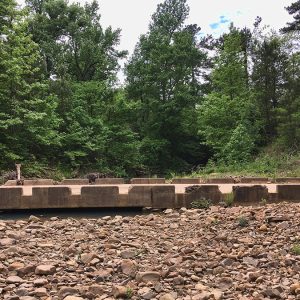calsfoundation@cals.org
Gate (Scott County)
The town of Gate is a historical community that was located in southern Scott County near the Polk County border. The community was originally established along a gated toll road (now Nella Road) and was subsequently named because of the actual “gate” that controlled the flow of traffic along the road. Gate was originally situated between the junction of Johnson Creek and Cedar Creek, which are tributaries of the Fourche La Fave River.
Prior to European exploration, Gate was a wilderness lush with native vegetation and numerous species of wildlife, some of which no longer inhabit the area. Early inhabitants of the area were present during the Woodland, Archaic, and Mississippian periods. There are numerous archaeological sites located along Clear Fork Creek, Black Fork Creek, and the Fourche La Face River north of Gate. This evidence indicates that the people of the Caddo tribe lived along major waterways near Gate.
Throughout the early seventeenth and late eighteenth centuries, French trappers and tradesmen left the Arkansas Post to traverse the landscapes and waterways of western Arkansas. There is little evidence of European exploration near Gate; however, it is probable that French trappers and tradesmen traveled down the Fourche La Fave to its head waters near the town of Gate.
One of the first roads in Scott County was constructed during the first survey of the area in the early 1840s. The road was initially known as “the road from Red River by Ouachita Cove to Fort Smith.” It entered Scott County through Foran Gap in Polk County just south of Gate. The road was later referred to as the Waldron-Dallas Road.
Gate’s earliest settlers, including the McLane, Coker, and Lunsford families, came to the area in the late 1860s and early 1870s.
In 1881, William Colburn secured a charter from the Scott County court to build Pike Road through the mountains and install a toll gate. The gate was originally located near the southern border of Scott County, with the charter being established for a twenty-year period. In order to protect the county’s interest, Neil Gist, Briggard Rogers, and John Odom were appointed to oversee construction of the gate. A year later, in May 1882, the Scott County Courthouse was destroyed by a fire, and with it the original records of the Pike Road charter. In August, the Scott County Court reinstated the original charter of the Pike Road toll gate. Two years later, in 1884, Colburn received permission to move the gate half a mile east on the Pike Road near his residence.
Gate received its first post office in April 1887, with James Holbird appointed the postmaster.
Very little is known about early residents of Gate; however, the Advance Reporter had several correspondents’ columns from Gate in the early 1900s. The writers of the neighborhood news columns did not want their names to be published, through most of the residents in Gate knew the identities of the columnists. Several of the columns were humorously signed as “Pork and Beans,” “Gobbler Hunter,” and “The Maid.” The topics of the columns ranged from weather to information on the lives of Gate’s citizens.
In the mid-1920s, Earnest and Fina Tharp settled in Gate near the area known as Broad Hollow. After three years, the couple built the Forest Park Hotel in Polk County just south of Colburn’s Pike Road gate. The building was reportedly two stories tall with a large lobby where dances were often held. The county road along which the hotel was located became U.S. Highway 71 in 1926. In the mid-1930s, the Forest Park Hotel burned down and was never replaced.
The Gate Post Office was discontinued in 1921 and the mail sent to Nella (Scott County). Not long after the closing of the post office, Gate was abandoned by its residents. The small town had had very little industry, with many of the residents working in the agricultural and timber industries.
Very little structural evidence of Gate remains. In the 1960s, the Wiley Winfield Scott Wood cabin was still standing, though it was in serious disrepair. In the twenty-first century, there is virtually no evidence left of the cabin. Small foundational remains exist from an old stone wall that was located on the toll road.
For additional information:
Biographical and Historical Memoirs of Western Arkansas. Chicago: Goodspeed Publishing Company, 1891.
Cate, Michael. History of Scott County, Arkansas. Dallas, TX: Curtis Media Corporation, 1991.
Goodner, Norman. A History of Scott County, Arkansas. Siloam Springs, AR: Bar D Press, 1941.
McCutcheon, Henry Grady. History of Scott County, Arkansas. Little Rock: H. G. Pugh and Company, 1922.
Ty Richardson
Richardson Preservation Consulting
 Cedar Creek
Cedar Creek  Gate View, North
Gate View, North  Johnson Creek Bridge
Johnson Creek Bridge  Scott County Map
Scott County Map 




Comments
No comments on this entry yet.